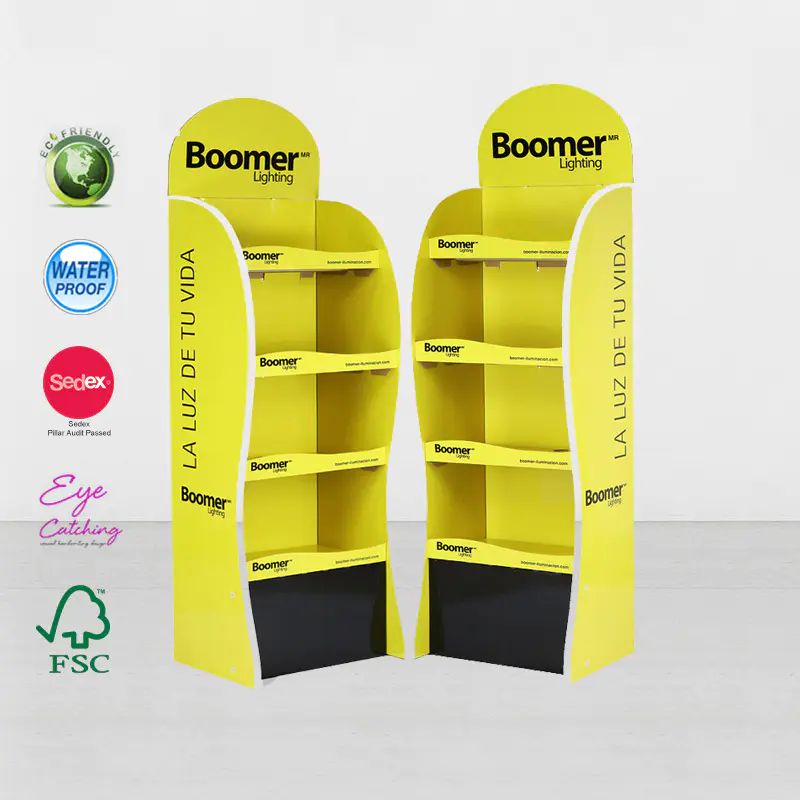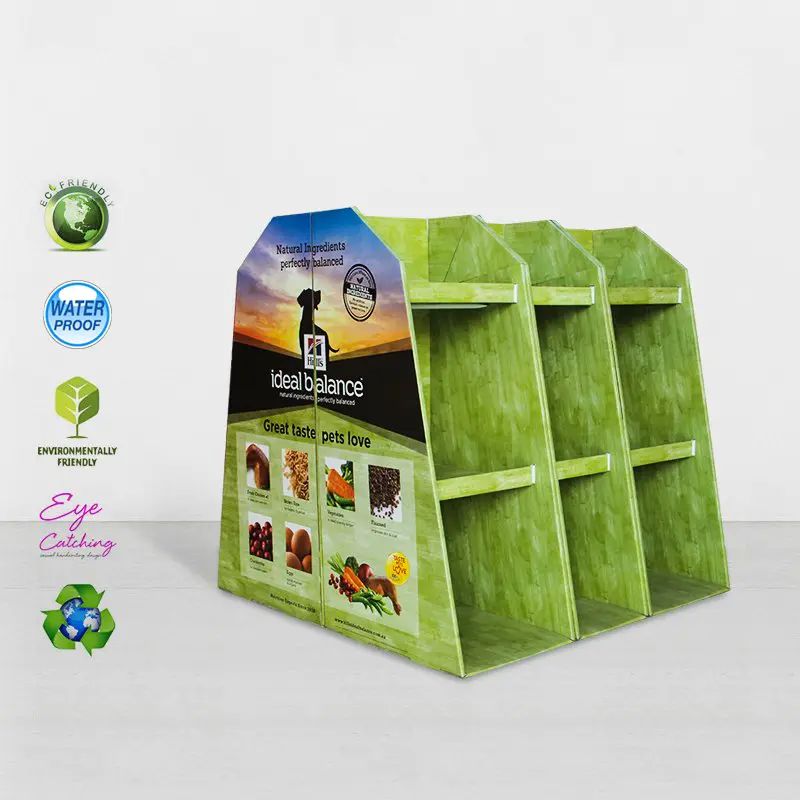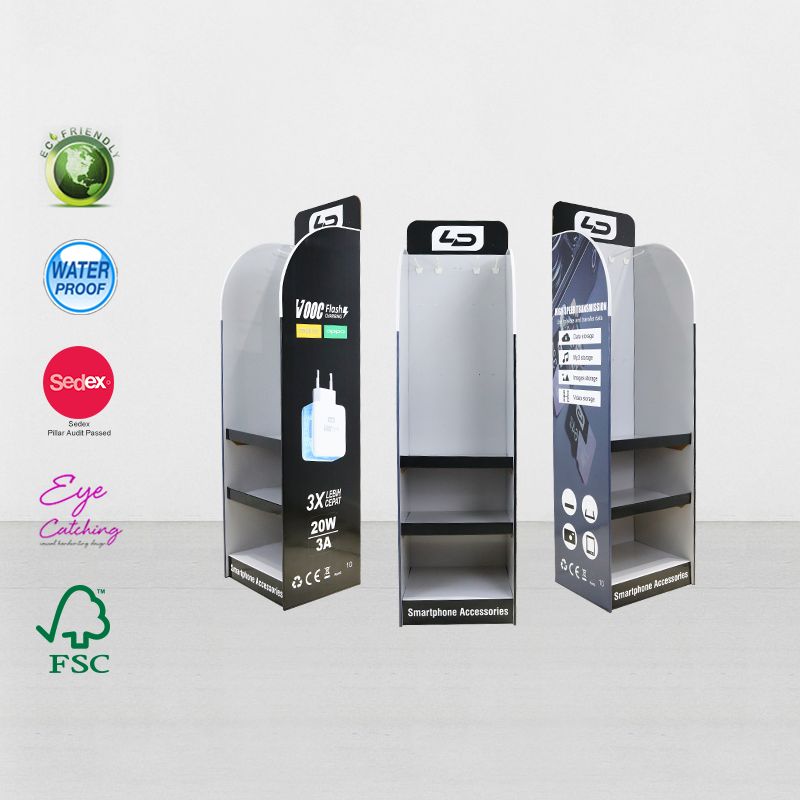In the retail industry, display racks serve as a bridge between merchandise and consumers. Whether in large supermarkets and convenience stores, or at various pop-up stores and promotional events, display racks play a vital role.
With the increasing awareness of environmental protection and the need for cost control, cardboard display racks are becoming a mainstream choice for retail displays. Not only are they lightweight, environmentally friendly, and recyclable, they can also be printed on to promote branding and sales.
Among the different types of cardboard display racks, cardboard floor displays, cardboard pallet displays, and cardboard hook displays are the three most common. They each have distinct characteristics in terms of structural design, load-bearing capacity, applicable merchandise, installation and transportation, and visual merchandising. This article will explore these three types of cardboard display racks in depth to help readers systematically understand their differences and applicable scopes.
Cardboard Displays: Do You Know What You Know?
Cardboard display racks are made primarily of corrugated cardboard, honeycomb cardboard, or composite cardboard, processed through cutting, folding, and splicing processes. Unlike wooden, metal, or plastic display racks, cardboard displays are lighter and can be flexibly customized in appearance and size to meet specific needs.
Their most prominent advantages include:
• Environmental friendliness: Cardboard is recyclable, aligning with green consumer trends.
• Cost-effectiveness: Low production costs make them suitable for short-term events or large-scale rollouts.
• Visual appeal: The cardboard surface is suitable for printing, allowing for brand logos, promotional information, and color schemes.
• Flexibility: Different designs can be tailored to the specific product characteristics, such as floor-mounted, pallet-mounted, and hook-mounted.
In practice, cardboard floor displays, pallet displays, and hook-mounted displays have become the three most common types used by retailers and brands.
What is a cardboard floor display?
1. Definition and Characteristics
A cardboard floor display is a freestanding cardboard display designed to stand directly on the floor. Made primarily of cardboard, it is self-supporting through folding and splicing, capable of supporting a certain weight of merchandise. This type of display typically features multiple display spaces and is suitable for locations such as supermarket aisles, checkout areas, and store entrances.
2. Structural Design
The design of a cardboard floor display often considers the following factors:
• Support Structure: Reinforced cardboard strips or a bottom support board are used to ensure overall stability.
• Number of Tiers: Generally, two to five tiers are used, which can be adjusted flexibly based on the height of the merchandise.
• Front Display Surface: A large printing area is reserved for branding and advertising.
• Detachability: Most cardboard floor displays can be folded for transportation and quickly assembled upon arrival.
3. Suitable Products
Cardboard floor displays are primarily used for light to medium-weight merchandise, such as biscuits, chocolates, beverage bottles, shampoo, cosmetics, and stationery. Due to their limited load capacity, they are not suitable for heavy or bulky items.
4. Advantages
• Outstanding visual marketing effect: Printing is possible across the entire display, easily attracting consumers' attention.
• Flexible Placement: The display can be placed anywhere in the store and quickly relocated.
• Low Cost: Suitable for temporary promotions and new product launches.
5. Limitations
• Limited load capacity: Unable to hold heavy merchandise for extended periods. • Lack of durability, suitable for short-term use.

What is a cardboard pallet display?
1. Definition and Characteristics
A cardboard pallet display uses a pallet as a base platform, with a cardboard structure built on top to display merchandise. The pallet portion, typically made of wood, plastic, or paper, provides support and facilitates transport, while the cardboard portion handles product display and visual promotion.
2. Structural Design
Typical cardboard pallet display designs include:
• Bottom pallet: Ensures load-bearing capacity and facilitates transport by forklift or hand truck.
• Stacking: Whole cases or bulk items can be stacked directly on the pallet, with cardboard wrapping or reinforcement.
• Modular design: A pallet is combined with the main display unit, allowing customization based on height requirements.
• Reinforcement: Cardboard corner guards or honeycomb cardboard are often used on the sides and corners to enhance stability.
3. Suitable Products
Cardboard pallet displays are ideal for large quantities or heavy goods, such as whole cases of beverages, large packaging for daily necessities, tissues, laundry detergent, etc. Its unique features include the ability to transport full pallets and be used directly as a display device in stores.
4. Advantages
• Strong load-bearing capacity: Can carry tens or even hundreds of kilograms of merchandise.
• High transportation efficiency: Pallets can be brought into the store and placed directly, saving labor.
• Durability: More durable than standard cardboard floor displays.
5. Limitations
• Higher cost than cardboard floor displays.
• Relatively bulky appearance, less visually appealing than pure display structures.

What is a cardboard hook display?
1. Definition and Features
A cardboard hook display is a display device that uses a cardboard support surface with metal or plastic hooks mounted on it for hanging small items. It can be placed freely on the ground or mounted on a wall or shelf.
2. Structural Design
Key design features of a cardboard hook display include:
• Hook mounting holes: Pre-set hook holes are provided on the cardboard panel.
• Hook support: Hooks are generally made of metal or sturdy plastic to ensure stability.
• Cardboard Reinforcement: Add multiple layers of cardboard at the hook holes to prevent tearing.
• Display: Large-area printing can be applied to the cardboard to highlight branding.
3. Applicable Products
Cardboard hook displays are particularly suitable for small, lightweight items such as charging cables, headphones, stationery, accessories, bagged snacks, razor blades, etc.
4. Advantages
• Clear product categorization: Different types of products can be neatly arranged according to the hook positions.
• High Space Utilization: Products are suspended in mid-air, saving floor space.
• High Flexibility: The number and position of hooks can be adjusted according to needs.
5. Limitations
• Limited load-bearing capacity, not suitable for heavy items.
• Inadequate reinforcement may cause tearing at the cardboard holes.

Floor, Pallet, and Hook: Comparison of Three Types of Cardboard Displays
Dimensions | Cardboard Floor Display | Cardboard pallet display | Cardboard hook display |
| Support Method | Free-standing structure | Pallet support | Hook hanging |
| Load Capacity | Lightweight to medium-weight | Medium to heavy loads | Lightweight |
| Applicable Products | Beverages, snacks, and cosmetics | Full-case containers of household chemicals, tissues, and beverages | Stationery, small accessories, bagged food |
| Transportation Method | Foldable for transportation and manual installation | Pallet transport, forklift handling | Separate shipping, manual installation |
| Visual Effect | Large display area | Low visual impact | Clear product assortment |
| Life Cycle | Short-term | Medium to long-term | Mid-term |
| Cost Level | Low | Medium to high | Medium |
Floor, Pallet, and Hook: Differences in Transportation and Installation Methods
1. Cardboard Floor Display
• Can be folded flat for transportation, saving logistics space.
• Manual assembly upon arrival at the store by unfolding and plugging.
2. Cardboard Pallet Display
• Suitable for full pallet shipping and can be operated directly by forklift.
• Requires almost no installation upon arrival at the store; simply place the display in its original location.
3. Cardboard Hook Display
• Often shipped in separate units, with a moderate transport volume.
• Installation requires manual insertion of hooks.
Floor, Pallet, Hook: Applicable Scenarios
1. Cardboard Floor Display: Ideal for short-term promotions, new product launches, and holiday events, emphasizing visual impact.
2. Cardboard Pallet Display: Ideal for large supermarkets and warehouse-style stores, emphasizing bulk display and load-bearing capacity.
3. Cardboard Hook Display: Ideal for convenience stores, electronic accessories sections, and small merchandise areas, emphasizing categorization and orderliness.
Are you searching for a reliable cardboard display supplier in China?
Caiyijie Printing has 21 years of experience in producing high-quality retail display solutions. Our factory integrates advanced equipment including digital proofing, CTP platemaking, 4-color printing machines, laminating lines, die-cutting machines, and automatic gluing systems.
From Cardboard Floor Displays to PDQ Boxes, Dumpbins, and Cutouts, our professional design and sales team ensures every order meets your branding, structural, and quality requirements.

